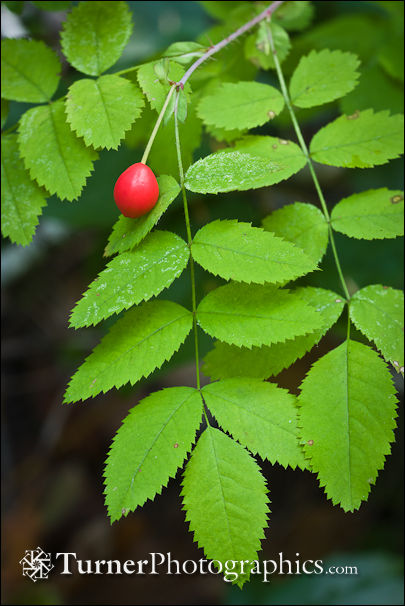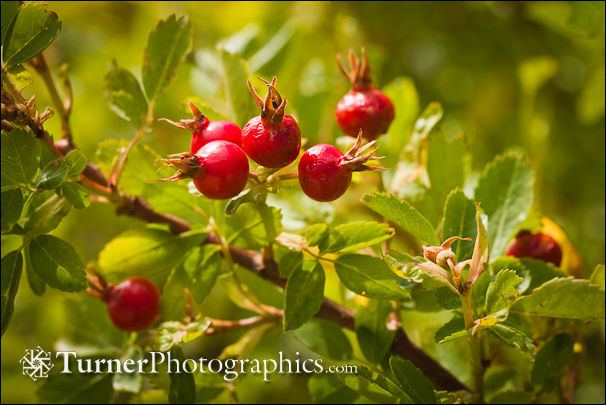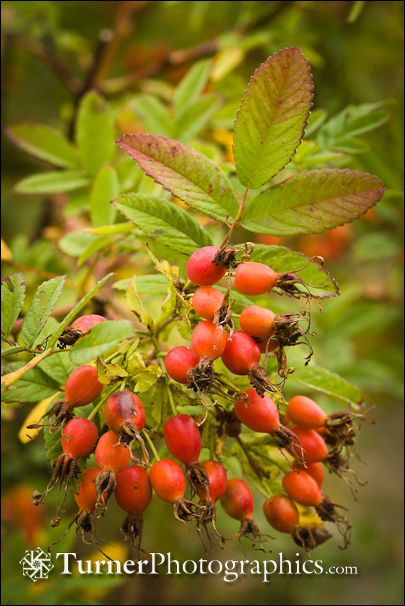Plant of the Month: Rose Hips
Autumn doesn’t come immediately to mind when I think of roses. Since my childhood, roses have been associated with warm summer days, with colorful blossoms emitting rich fragrances that waft across the garden on gentle breezes. We stop in the rose garden and inhale deeply of the heady aroma.This time of year roses put on a different kind of show, with brilliant fruit dangling at the end of branches against a background of fading and soon-to-be-fallen foliage. In singles and in large clusters, rose hips are showy. If you’re a gardener, or have visited a public garden in the fall, you’ve surely seen the giant hips on rugosa roses.Our northwest native roses also have showy hips. Depending on where you live you might have baldhip rose (Rosa gymnocarpa), Nootka rose (Rosa nutkana), Woods’ rose (Rosa woodsii var. ultramontana), or clustered rose (Rosa pisocarpa).
Baldhip Rose
 Baldhip rose is the smallest of these four common northwest wild roses in the northwest. It’s also the most shade-tolerant and grows along shady forest edges, sometimes appearing a bit straggly. Give it more light and it will form a more vigorous shrub.Baldhip rose gets its name from its hips, which have no lingering sepals attached because they fall off early. I’ve only seen a few hips on each baldhip shrub, so it’s not the showiest of the bunch.See more baldhip rose photos.
Baldhip rose is the smallest of these four common northwest wild roses in the northwest. It’s also the most shade-tolerant and grows along shady forest edges, sometimes appearing a bit straggly. Give it more light and it will form a more vigorous shrub.Baldhip rose gets its name from its hips, which have no lingering sepals attached because they fall off early. I’ve only seen a few hips on each baldhip shrub, so it’s not the showiest of the bunch.See more baldhip rose photos.
Nootka Rose

Nootka rose is our most common large native rose on the west coast from Alaska all the way down to Mendocino County, California. It forms dense thickets from near the saltwater shoreline up to middle elevations. Nootka roses need a sunny habitat to thrive. You’ll occasionally see an old bush struggling to survive as taller trees and shrubs begin to shade it out. Flowers are carried singly or in small open groups, and so are the large reddish-orange hips which may linger long into the winter.See more Nootka rose photos.
Woods’ Rose

Woods’ rose is the common species on the drier east side of the Cascades all the way down to southern California and across the continent into the midwest. It’s also a thicket-forming sun lover found along roadsides and in meadows or fields. Large single pink blossoms in June yield rich red pear-shaped hips by September. Another common name for this species is pearhip rose. There are several varieties of this species. The one we have throughout Washington is var. ultramontana.See more Woods’ rose photos.
Clustered Rose
 Clustered rose is another west of the mountains sun-loving species that grows as far south as Mendocino County. It doesn’t form thickets quite as dense as those of Nootka rose and as the name suggests, its pink flowers come in dense clusters. Blossoms are followed this time of year by orange to almost purple hips, also appearing in bunches.This clustered rose was photographed in my mother-in-law’s garden this morning, October 4.See more clustered rose photos.These four native roses can all make nice specimen plants in a natural garden. They provide both habitat and food for wildlife as well giving three-season visual interest. Some people like to make rose hip tea and native peoples had multiple uses for parts of the rose bushes.
Clustered rose is another west of the mountains sun-loving species that grows as far south as Mendocino County. It doesn’t form thickets quite as dense as those of Nootka rose and as the name suggests, its pink flowers come in dense clusters. Blossoms are followed this time of year by orange to almost purple hips, also appearing in bunches.This clustered rose was photographed in my mother-in-law’s garden this morning, October 4.See more clustered rose photos.These four native roses can all make nice specimen plants in a natural garden. They provide both habitat and food for wildlife as well giving three-season visual interest. Some people like to make rose hip tea and native peoples had multiple uses for parts of the rose bushes.

